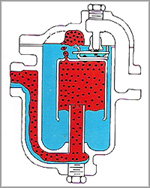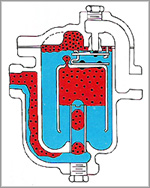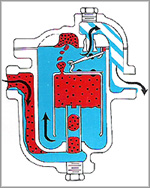 |
圖 B-1
當最初的冷凝水進入疏水閥內時經由通水管及桶子的下緣而出,這時因桶子重往下沉落,控制閥閘因而也跟張開,然後冷凝水就經過張開的閥門口排放出。
FIG. B-1
In the beginning, the condensate flows internally from the bottom edge of the passage tube of the bucket. This cause the bucket to sink down due the heavy weight. As a result, the valve is widely opened.
Therefore the condensate is discharged through the Widely-Opened valve. |
|
 |
圖 B-2
冷凝水排放過後,這時來的蒸汽將桶子住上推頂,連帶頂住控制閥,直到關閉為止。接著空氣及二次蒸汽由桶子上端的出汽孔排出,當任何蒸汽經過時都會凝結成冷凝水。
FIG. B-2
After a while. The condensate is completely discharged out and at the same time the incoming steam rises the bucket up to the top and force the valve to close. Then the air and secondary steam pass through the bucket outlet. When any steam passing though the bucket is condensed as condensate. |
|
|
 |
圖 B-3
當冷凝水進入後,會使水位升高,在水平高於中線時,桶子會輕微的拉動連桿。然而控制閥尚未打開,直到冷凝水位到達打開線。這時蒸汽和冷凝水回收頭之間有壓差。
FIG. B-3
When the condensae enters the ducket. It causes the level to rise, Upwards. When the level rises above the middle line, it slightly pull on the lever but the valve is not opened yet. On the other hand, it opens the valve when the level reaches the opening line due the pressure difference between the steam and the condensate return header. |
|
|
 |
圖 B-4
當冷凝水位到達打開線時桶的重量乘上槓桿率,就超過控制閥的壓力,桶子瞬間就下沈而拉開閥閘。隨後累積的空氣也曾眼者冷凝水一起被排放掉。這個排放動作一直持續到更多的蒸汽進來,使桶子再度漂浮頂住這樣一來.整個循環又重新開始。
FIG. B-4
If the condensate level reaches the opening line, then the product of the weight of the bucket tines the leverage exceed the pressure of the valve. The bucket immediately sink down and cause the valve to open. The accumulated air is also discharged after the discharging of the condensate. This action will maintain until more and more incoming steam cause the bucket to float up. As a sequence, the cycle begins to repeat. |
|

